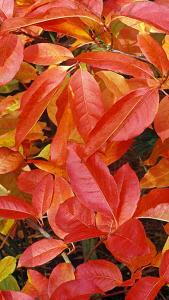Oxydendrum Arboreum Sorrel Tree
1. Add items to basket
2. Go to the basket
3. Enter your postcode in Delivery Price Check
Pot size: 15 Litres
Plant ID: 2709 64
View plant size:PRE-ORDER
Pay to pre-order this plant for delivery estimated by 31.10.2026
The Sorrel Tree, also known as Sourwood, Latin name Oxydendrum Arboreum is a decorative deciduous tree that offers a low maintenance, architectural specimen with multi-seasonal interest for your lawn, patio, shade garden or open woodland areas.
A member of the Family Ericaceae, the Genus Oxydendrum occur as shrubs or trees typically with lance-shaped or oblong leaves known for their brilliant blaze of colour in the autumn. The Genus typically has panicles of small white flowers, cylindrical in shape, that bloom in late summer or early autumn. The Oxydendrum Arboreum variety is a larger shrub or tree with alternate leaves that are glossy and finely toothed. Their colouration in the autumn occurs as a brilliant red. Their small, white, drooping flowers, similar to those of lily-of-the-valley occur in late summer with a slight fragrance. When the flowers pollinate, they give way to a silver-grey coloured, dry capsule which contrasts well with the brilliant red foliage during autumn.
A native of the Eastern US, from Pennsylvania south to Florida and west to Ohio, the deciduous sourwood tree will grow to an ultimate height of 8-12 metres, and an ultimate spread of 4-8 metres. A long lived tree, it takes from 25-50 years to reach its ultimate growth. In its native locations, it is often found growing along with rhododendron and azaleas because like them, it prefers an acidic soil. In the wild, it can grow to 20 metres with its straight, slender trunk and narrow crown. The bark on the mature Sorrel Tree is grey and ridged, and has a sour taste, hence the name, Sourwood. Their flowers are hermaphrodite, meaning they have both male and female organs in the same flower.
Hardy in the UK and Ireland to Zone H6, Oxydendrum Arboreum will tolerate most any position from full to partial sun, even to shade. In order of preference, their Aspect can be North, East, South, or West facing. They like to be sheltered from cold dry winds of winter. They should be grown in soils with acid pH, moist, but well drained so as to not have wet feet for extended periods of time. Loam, clay, or sand are all quite suitable for the Sorrel Tree.
Items of note include Sorrel Trees are quite attractive to bees. Sourwood honey is a prized local product in the South Eastern and Eastern US. There are few insect or disease problems, though when conditions are right, the occasional leaf spot and twig blight are remotely possible.












